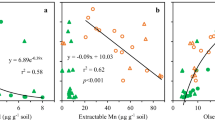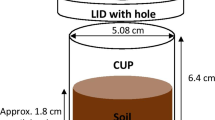Abstract
The mechanisms by which organic materials affect soil pH are not fully understood. This study for the first time compared the short-term effect of various model organic compounds on pH change of two soils differing in initial pH (Podosol of pH 4.4 and Tenosol of pH 6.1). Eight organic compounds, representing common compounds in plant residues, were selected based on the number and type of chemical functional groups. The addition of organic acids (acetic, malic, citric, and benzoic acid) reduced soil pH immediately due to H+ dissociation. The magnitude of pH decrease depended on the rate of application, degree of dissociation of the acids, and initial soil pH. During a subsequent incubation, pH was slowly restored as these compounds were decomposed. The degree to which pH was restored was reduced with increasing addition rate. The production of H+ ions was increased with increasing rate of acid addition and decreased over time. When potassium citrate (organic anion) was added, soil pH increased due to H+ consumption upon decomposition. Compounds with amine groups (glucosamine hydrochloride) and less easily decomposable compounds (phenol) did not significantly alter pH during 16-day shaking. Changes in pH after glucose addition were relatively small compared with other compounds and were not expected because hydroxyl chemical groups of glucose are neutral. The present study demonstrated that the addition of model organic compounds to soil caused soil pH to increase, decrease, or remains unaffected. The extent and direction of pH change was dependent on the chemical functional group, addition rate, decomposition, and the initial soil pH.






Similar content being viewed by others
References
Ano AO, Ubochi CI (2007) Neutralization of soil acidity by animal manures: mechanism of reaction. Afr J Biotechnol 6:364–368
Asami DK, Hong YJ, Barrett DM, Mitchell A (2003) Comparison of the total phenolic and ascorbic acid content of freeze-dried and air-dried marionberry, strawberry, and corn grown using conventional, organic, and sustainable agricultural practices. Agric Food Chem 51:1237–1241
Bolan NS, Hedley MJ, White RE (1991) Process of soil acidification during nitrogen cycling with emphasis on legume based pastures. Plant Soil 134:53–63
Bot A, Benites J (2005) The importance of soil organic matter. FAO Soils Bulletin 80.
Brady NC, Weil R (2002) The Nature and Properties of Soils. Prentice Hall, New Jersey
Butterly CR, Bunemann EK, McNeil AM, Baldock JA, Marschner P (2009a) Carbon pulses but not phosphorus pulses are related to decreases in microbial biomass during repeated drying and rewetting of soils. Soil Biol Biochem 41:1406–1416
Butterly CR, Baldock JA, Xu JM, Tang C (2009b) Is the alkalinity within agricultural residues soluble? In: Xu JM, Huang PM (eds) Molecular Environmental Soil Science at the Interfaces in the Earth’s Critical Zone. Springer/Zhejiang University Press, Hangzhou, China, p 316
Chorom M, Rengasamy P (1997) Carbonate chemistry, pH, and physical properties of an alkaline sodic soil as affected by various amendments. Aust J Soil Res 35:149–161
Essington ME (2004) Soil and Water Chemistry: An Integrative Approaches. CRC press LLC, Florida.
Gee GW, Bauder JW (1986) Particle-size Analysis. In: Klute A (ed) Methods of Soil Analysis, 2nd edn. American Society of Agronomy, Inc., Soil Science Society of America, Inc, Madison, WI, pp 337–423
Ghollarata M, Raiesi F (2007) The adverse effects of soil salinization on the growth of Trifolium alexandrinum L. and associated microbial and biochemical properties in a soil from Iran. Soil Biol Biochem 39:1699–1702
Gunnarsson S, Marstorp H (2002) Carbohydrate composition of plant materials determines N mineralisation. Nutr Cycl Agroecosyst 62:175–183
Isbell RF (2002) The Australian Soil Classification (revised edition). CSIRO, Collingwood, Victoria
Jenkinson DS (1977) Studies on the decomposition of plant material in soil. IV. The effect of rate of addition. Eur J Soil Sci 28:417–423
Jones DL (1998) Organic acids in the rhizosphere-a critical review. Plant Soil 205:25–44
Jones DL, Kemmitt SJ, Wright D, Cuttle SP, Bol R, Edwards AC (2005) Rapid intrinsic rates of amino acid biodegradation in soils are unaffected by agricultural management strategy. Soil Biol Biochem 37:1267–1275
Kemmitt SJ, Wright D, Goulding KWT, Jones DL (2006) pH regulation of carbon and nitrogen dynamics in two agricultural soils. Soil Biol Biochem 38:898–911
Li ZA, Zou B, Xia HP, Ding YZ, Tan WN, Fu SL (2008) Role of low-molecule-weight organic acids and their salts in regulating soil pH. Pedosphere 18:137–148
Marschner B, Kalbitz K (2003) Controls of bioavailability and biodegradability of dissolved organic matter in soils. Geoderma 113:211–235
Marschner B, Noble AD (2000) Chemical and biological processes leading to the neutralisation of acidity in soil incubated with litter materials. Soil Biol Biochem 32:805–813
Mengel K (1996) Turnover of organic nitrogen in soils and its availability to crops. Plant Soil 18:83–93
Mokolobate MS, Haynes RJ (2002) Increases in pH and soluble salts influence the effect that additions of organic residues have on concentrations of exchangeable and soil solution aluminium. Eur J Soil Sci 53:481–489
Motavalli PP, Palm CA, Parton WJ, Elliott ET, Frey SD (1995) Soil pH and organic C dynamics in tropical forest soils: evidence from laboratory and simulation studies. Soil Biol Biochem 27:1589–1599
Ritchie GSP, Dolling PJ (1985) The role of organic matter in soil acidification. Aust J Soil Res 23:569–576
Roberts PR, Bol R, Jones DL (2007) Free amino sugar reactions in soil in relation to soil carbon and nitrogen cycling. Soil Biol Biochem 39:3081–3092
Schwab AP (2000) The soil solution. In: Sumner ME (ed) Handbook of Soil Science. CRC Press LLC, Florida, pp B85–B120
Senwo ZN, Tabatabai MA (1998) Amino acid composition of soil organic matter. Biol Fertil Soils 26:235–242
Shen Y, Strom L, Jonsson JA, Tyler G (1996) Low-molecular organic acids in the rhizosphere soil solution of beech forest (Fagus Sylvatical L.) Cambisols determined by ion chromatography using supported liquid membrane enrichment technique. Soil Biol Biochem 28:1163–1169
Strobel BW (2001) Influence of vegetation on low-molecular-weight carboxylic acids in soil solution-a review. Geoderma 99:169–198
Tang C, Sparling GP, McLay CDA, Raphael C (1999) Effect of short-term legume residue decomposition on soil acidity. Aust J Soil Res 37:561–573
Tang C, Yu Q (1999) Impact of chemical composition of legume residues and initial soil pH on pH change of a soil after residue incorporation. Plant Soil 215:29–38
Tripathi S, Kumari S, Chakraborty A, Gupta A, Chakrabarti K, Bandyapadhyay BK (2006) Microbial biomass and its activities in salt-affected coastal soils. Biol Fertil Soils 46:273–277
Vickery HB, Pucher GW (1940) Organic acids of plants. Ann Rev Biochem 9:529
Wang P, Zhou R (2006) Determination of organic acids exuded from plant roots by high performance liquid chromatography. Chin J Chromatogr 24:239–242
Williams CH (1980) Soil acidification under clover pasture. Aust J Exp Agric Anim Husb 20:561–570
Xu JM, Tang C, Chen ZL (2006a) The role of plant residues in pH change of acid soils differing in initial pH. Soil Biol Biochem 38:709–719
Xu JM, Tang C, Chen ZL (2006b) Chemical composition controls residue decomposition in soils differing in initial pH. Soil Biol Biochem 38:544–552
Yan F, Schubert S (2000) Soil pH changes after application of plant shoot materials of faba bean and wheat. Plant Soil 220:279–287
Yan F, Schubert S, Mengel K (1996) Soil pH increase due to biological decarboxylation of organic anions. Soil Biol Biochem 28:617–624
Yuan BC, Li ZZ, Liu H, Gao M, Zhang YY (2007) Microbial biomass and activity in salt affected soils under arid conditions. Appl Soil Ecol 35:319–328
Acknowledgements
This work was supported by the Australian Research Council (Discovery project DP0877882) and the National Natural Science Foundation of China (40728001). We are grateful to Dr. Helen Hayden for reviewing the manuscript and Ms. Giang Nguyen (Jenny) for technical assistance.
Author information
Authors and Affiliations
Corresponding author
Rights and permissions
About this article
Cite this article
Rukshana, F., Butterly, C.R., Baldock, J.A. et al. Model organic compounds differ in their effects on pH changes of two soils differing in initial pH. Biol Fertil Soils 47, 51–62 (2011). https://doi.org/10.1007/s00374-010-0498-0
Received:
Revised:
Accepted:
Published:
Issue Date:
DOI: https://doi.org/10.1007/s00374-010-0498-0




